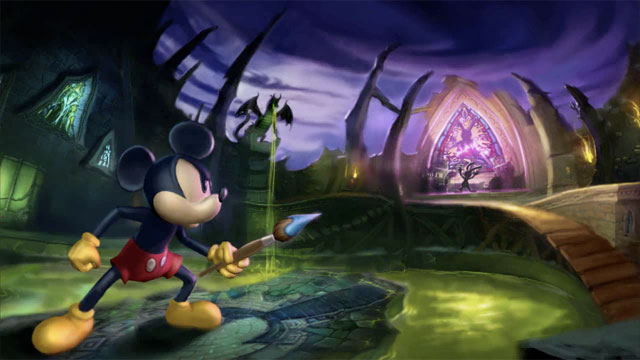Summary: Mickey Mouse steps into a ravaged world of forgotten Disney characters, and learns that he is responsible for their plight. Commence cartoony world-saving.
Verdict: As some others have said, this game is more than the sum of its parts. Worth playing if you’re into Disney and pretty good at 3D action-platforming.
Impressions with spoilers after the break.
First, my experience and bias: I’ve played through the game once, tending toward generally heroic behavior. I’ve read a couple of reviews.
Most criticisms of this game are obvious and have been pointed out across the internet: The camera isn’t too smart, there are a few quest bugs, the whole experience (from menus to fetch quests) doesn’t have the polish and playability of a Super Mario Galaxy. I don’t want to excuse this with a Disney budget, but we’ll move on for now.
The game borrows heavily from Mario and Zelda (complete with an obvious Zelda reference) but I found the experience was the antithesis of these games. See, when I play Mario I go out of my way to collect all the stars. I go back and replay levels because I want to experience everything, and because there’s a chance to unlock more challenging content. Zelda is similar with side-quests (skulltulas, anyone?) and heart containers. The search and the satisfaction of cleaning out the game of its treasures is part of the fun in these games. Epic Mickey turns this kind of play on its head by hiding a plethora of collectibles in the world, and making it literally impossible to collect them all (in one trip through the game).
You see, Epic Mickey is a one-way trip. I expected a game about player agency built around a hub world to give me quite a bit of freedom to tackle challenges in any order. In reality, Epic Mickey is relentlessly linear. You’re moved from one small area to another, the doors lock behind you, and the game autosaves frequently so if you miss anything, it’s gone. (My wife would hate this game.) That’s the whole point, though: The game’s exposition shows the permanent damage Mickey has done to Wasteland, and the rest of the game is about the indelible mark you choose to leave on the world (and on yourself) from moment to moment.
The major decisions (in particular, those that impact the ending) are binary: Did you use paint or thinner on the clock tower? Did you rebuild Goofy or not? Did you exit the throne room via screen A or B? But the decisions always require action (instead of a menu option) and they are usually very different in execution. My favorite situations were those where the “good/paint” option was substantially more challenging than the “bad/thinner” option, or where it wasn’t immediately obvious that there was a good option at all. It felt like I was being substantially rewarded for taking the road less traveled, which is surprisingly rare in games considering how common it is to the hero epic. In the end, I was rewarded with a surprisingly touching ending that reflected on lots of decisions I made while playing. I think it’s worth noting that only one key decision is made during the endgame (and it’s a fairly long endgame). The way you treat others is important throughout the game.
In the end, I found the game more satisfying than I expected. I had a strong desire to play again and see what I could change, but for now I think I’ll leave it. I like the idea that I had an impact on Wasteland, and it would be unnerving to see it undone now. I’ve scanned online instead, and most of the discussion is about how you have to run through the game three times to collect everything. I say they’re missing the point. You can’t have everything. You can only make your choices and live with them.
I applaud the Junction Point team for making such an unusual, uncomfortable game. I recommend the experience, but completionists have been warned.
